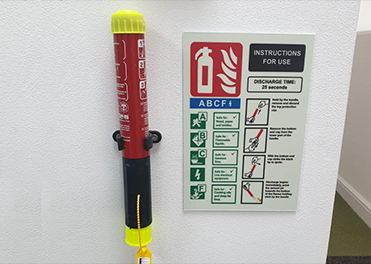What’s Fire Safety Stick and How Does It Work?

Fire safety is a crucial aspect of protecting lives and property, whether at home, in the workplace, or enjoying the great outdoors. While traditional fire extinguishers are invaluable, they can be bulky and require some training. The Fire Safety Stick offers a compact, user-friendly alternative for tackling smaller fires. In this blog, we’ll dive into the details of this innovative device. We’ll cover its strengths and limitations, explain how it works across various fire types, provide clear instructions for use, and outline its technical specifications. Get ready to learn about a new tool in your fire safety arsenal!
What’s Fire Safety Stick?
The Fire Safety Stick is a compact and easy-to-use fire suppression tool. It’s a great alternative to traditional extinguishers, offering mess-free operation with a simple, match-like activation. Unlike pressurized extinguishers, it eliminates risks of malfunction and doesn’t require maintenance. The Fire Safety Stick effectively tackles a wide variety of fire types (classes A through F), making it a versatile safety device.
How Does Fire Safety Stick Work?
The Fire Safety Stick (FSS) operates using a distinctive approach to fire suppression, utilizing a potassium ion jet, unlike traditional fire extinguishers which often rely on water, foam, or dry chemical agents. Here’s a simplified explanation of how it works:
1. Activation and Chemical Release
The FSS contains a mixture of solid minerals, primarily composed of Potassium Nitrate, an organic oxidizer, and a plasticizer resin. It is not pressurized nor does it contain any gas under normal conditions. The device is activated by striking its base, which initiates a chemical reaction inside the stick, transforming the solid compound into an aerosol jet without any thrust. This aerosol is essentially an inert salt that emits nitrogen gas, a component already presents in our atmosphere.
2. Physical and Chemical Reactions
Upon activation, the FSS undergoes two key reactions:
- • The physical reaction involves the rapid oxidation of potassium ions (free radicals) when exposed to air. These ions consume significant amounts of oxygen, effectively starving the fire of one of its essential components for combustion.
- • Simultaneously, a chemical reaction takes place, creating a stable bond between potassium particles and the combustion particles of the fire. This reaction facilitates a quick oxidation process, transforming the emitted jet from a solid state into gaseous potassium particles. These particles are adept at intercepting and neutralizing the free radicals generated by the fire’s combustion process, thus disrupting the fire’s chain reaction.
3. Fire Extinguishing Process
The primary extinguishing mechanism is the potassium radicals (K+) from the aerosol, which capture the oxygen molecules involved in the fire’s combustion. By removing oxygen, the fire is effectively extinguished. The process concludes with the discharge of the following into the atmosphere:
- Solid particles: These are potassium particles that have reacted with the oxygen in the fire, with sizes between 3-4 microns. These particles, while invisible to the naked eye, are heavier than air, dispersing into the atmosphere and settling on the ground in negligible amounts.
- Gases: Nitrogen gas, an inert substance constituting about 78% of the air we breathe, along with water vapor, and extremely minimal amounts of toxic by-products from the combustion. The quantity of these by-products is so small that it poses no risk of electrical conduction.
The use of a potassium ion jet for fire suppression is what sets the Fire Safety Stick apart, offering a non-pressurized, eco-friendly, and effective method for extinguishing fires across a broad range of classes, without leaving harmful residues or requiring complex clean-up processes.
Advantages of Fire Safety Stick
- Ease of Use: Simple activation method similar to striking a match makes it accessible to everyone, including children and the elderly.
- Portability: Lightweight and compact design allows for easy storage and transportation.
- Versatility: Effective against various fire classes (A, B, C, D, E, and F).
- Safe: No pressurization means no risk of rupture or accidental discharge.
- Maintenance-Free: No refills or inspections are needed, simplifying long-term use.
- Eco-friendly: Creates less mess and residue compared to some traditional extinguishers.
Disadvantages of Fire Safety Stick
- Limited Capacity: Intended for smaller fires and suppressing the initial stages of a fire; less effective on larger, well-established fires.
- Short Discharge Time: The chemical reaction lasts for a limited period, so you need to act quickly.
- Potential for Re-ignition: If the source of the fire is not completely eliminated, there’s a risk that the fire could restart.
- Heat Sensitivity: Extreme heat may affect the device’s performance.
- Overall: The Fire Safety Stick is an excellent tool for early fire suppression and can be a valuable addition to your home safety toolkit. However, it’s important to remember it’s not a full replacement for a traditional fire extinguisher in all situations.
Fire Classes the Fire Safety Stick Works On
The Fire Safety Stick is designed to combat various types of fires, making it a versatile tool for fire safety. It is effective against the following classes of fires:
Class A: Ordinary Combustibles
- Materials: Wood, paper, cloth, plastics, and similar everyday materials.
- How the Fire Safety Stick Helps: The stick releases nitrogen to displace oxygen and potassium, which reacts with oxygen to further deprive the fire.
Class B: Flammable Liquids
- Materials: Gasoline, oil, grease, solvents, and other flammable liquids.
- How the Fire Safety Stick Helps: It smothers the fire with nitrogen and deprives it of oxygen, disrupting the combustion process needed for these liquids to burn.
Class C: Electrical Fires
- Materials: Energized electrical equipment, wiring, appliances, etc.
- How the Fire Safety Stick Helps: The non-conductive chemicals in the stick mean it can be used safely on electrical sources. It again works by smothering the fire and cutting off the oxygen supply.
Class D: Combustible Metals
- Materials: Magnesium, sodium, potassium, titanium, etc.
- How the Fire Safety Stick Helps: Not the primary use case, but it can assist in suppressing oxygen-dependent combustion of some metals due to its oxygen suppression properties.
Class E: Energized Electrical Equipment (Australia/NZ)
- Materials: Similar to Class C, but a specific classification in these countries.
- How the Fire Safety Stick Helps: As with Class C, its non-conductive nature and oxygen suppression make it useful.
Class F: Cooking Oils and Fats
- Materials: Deep fryers, grease build-up in cooking areas, etc.
- How the Fire Safety Stick Helps: The chemicals suppress the fire’s combustion and can create a layer that helps prevent the superheated fats and oils from re-igniting.
- Important Note: While the Fire Safety Stick is effective for these classes, it’s primarily intended for quickly controlling smaller, initial-stage fires. Always follow the manufacturer’s instructions and have a backup plan in case of larger fires.
How to Use Fire Safety Stick
Using the Fire Safety Stick involves a straightforward process designed for quick activation and ease of use during emergency situations. Here’s a simplified guide on how to use it:
Step 1: Prepare The Stick
- Handle with Care: Start by holding the Fire Safety Stick by its black plastic handle, ensuring it’s pointed away from your body and face for safety.
- Cap Removal: Locate and remove the top protection cap that covers the black resin tip of the stick. This is to expose the part of the stick that will be ignited.
Step 2: Ignition Preparation
- Striker Cap: Find the bottom-end striker cap located at the lower end of the handle. Detach this cap to reveal a red/brown rough surface inside it, designed for igniting the stick.
Step 3: Activation
- Strike to Ignite: Hold the striker cap with the red/brown tip facing the black resin tip of the stick. Strike the resin sideways with the striker cap, mimicking the action of lighting a match. This action should ignite the stick.
- If the stick does not ignite on the first attempt, repeat this striking action until it successfully ignites.
Step 4: Extinguishing The Fire
- Direct the Jet: Once the stick is ignited and the discharge starts, aim the jet towards the base of the fire. Maintain a safe distance while holding the stick by the handle and point it at the flames to start extinguishing the fire.
- The discharged agent is harmless, and you might notice a few sparks or a small amount of black soot being emitted, which are also harmless and can be easily cleaned up afterward.
Additional Tips
- • The Fire Safety Stick’s design ensures that it can be activated quickly and used by anyone, without the need for prior training. Its simplicity makes it a valuable tool for emergency fire suppression in various settings.
- • Remember to always prioritize safety. If a fire is too large or if you’re unsure about your ability to extinguish it safely, evacuate the area and call professional firefighters.
Specifications of Fire Safety Stick
The Fire Safety Stick offers several key specifications that make it a standout choice for fire suppression:
- Extended Shelf Life: Surpasses traditional extinguishers with a remarkable shelf life of 15 years, significantly longer than the typical 5-year lifespan of many conventional fire extinguishers.
- Varied Discharge Duration: Offers two models with different discharge times to suit various needs: one lasting 50 seconds and another 100 seconds. This feature stands in stark contrast to the average discharge time of around 7 seconds for a 1kg powder extinguisher.
- Compact and Lightweight: Available in two models, the FSS50 weighs only 215 grams, and the FSS100 weighs 365 grams. This makes the Fire Safety Stick about 10% of the weight of a standard 1kg powder extinguisher, which typically weighs around 2.2kg.
- Versatility in Fire Classes: Engineered to address a broad spectrum of fire types, including Class A (Flammable Materials), Class B (Flammable Liquids), Class C (Flammable Gases), Electrical Fires (up to 100,000 volts), and Class F (Cooking Oils & Fats).
- Mess-Free Operation: Unlike traditional fire extinguishers, the Fire Safety Stick leaves no harmful residue or mess behind, minimizing the need for cleanup, downtime, or equipment replacement.
- Maintenance-Free: Requires no professional servicing. A simple visual inspection is all that is recommended for regular maintenance, easily performed by any responsible individual.
- Safety During Use: Its discharge does not impair the user’s ability to breathe or see, making it safe to use even in confined spaces.
- Emergency Use Feature: In situations where a fire is beyond control, the Fire Safety Stick can be activated and left in the vicinity of the fire before exiting the area. It continues to suppress the fire even in the absence of the user.
- Environmental Consideration: The discharge from the Fire Safety Stick does not contribute to global warming or ozone depletion, making it an environmentally friendly choice for fire suppression.
- Recyclability: After use, the Fire Safety Stick can be easily separated into its aluminium tube and plastic handle components for straightforward recycling.
- Tested Durability: Demonstrates resilience and continued functionality even after being subjected to extreme conditions, such as piercing, sawing, submersion in water, and drops from shoulder height, ensuring its reliability in extinguishing fires.
Conclusion
The Fire Safety Stick presents a valuable addition to your overall fire safety plan. Its ease of use, portability, and effectiveness on various fire types make it a smart choice for homes, vehicles, and outdoor adventures. While it shouldn’t completely replace traditional extinguishers, it provides a quick response option for tackling those initial, potentially dangerous fire outbreaks. Remember, fire safety is a continuous process – stay informed, be prepared, and always prioritize the safety of yourself and others!
- (This "Fire Safety Blogs" Published in April 2024 Edition)












